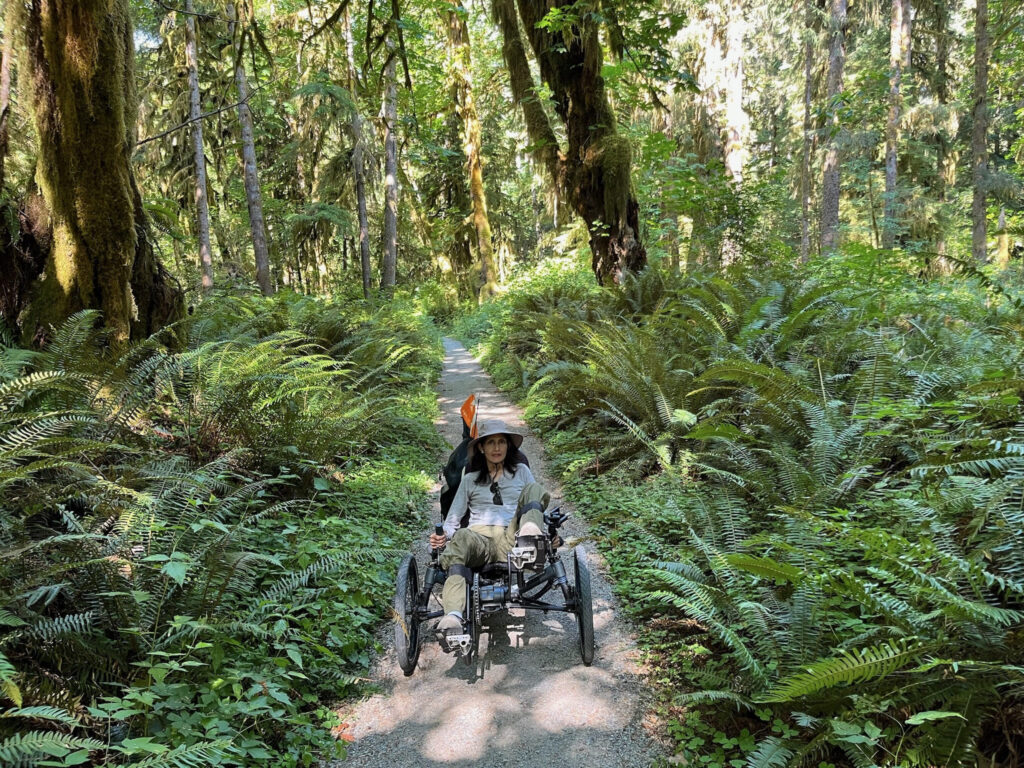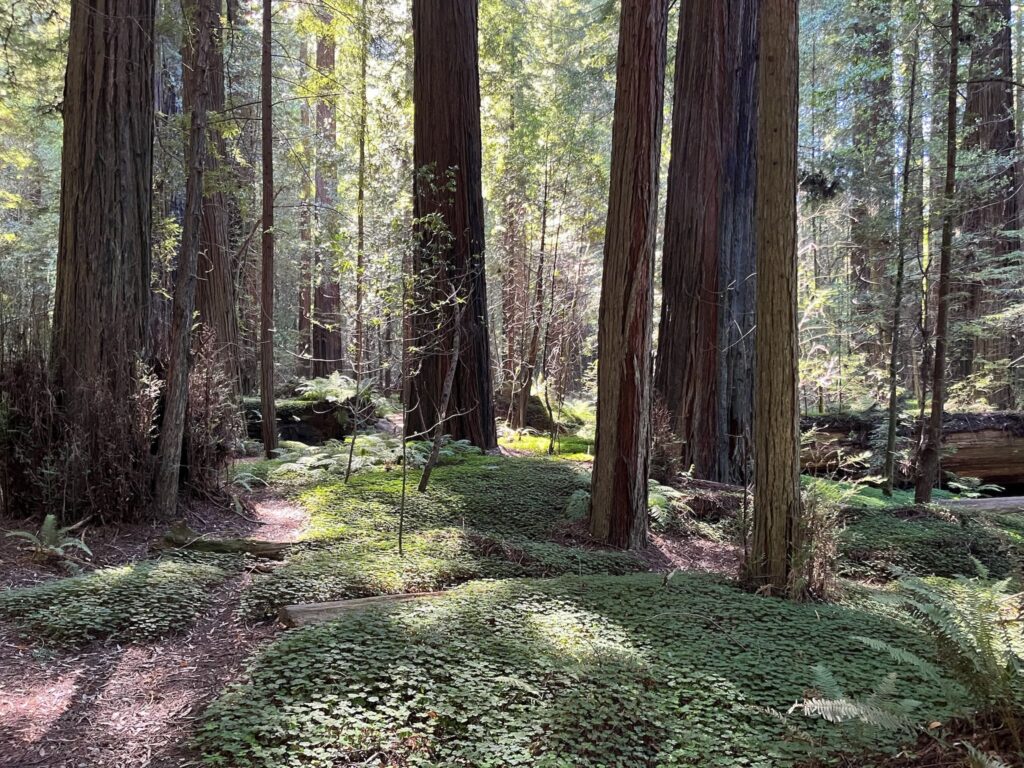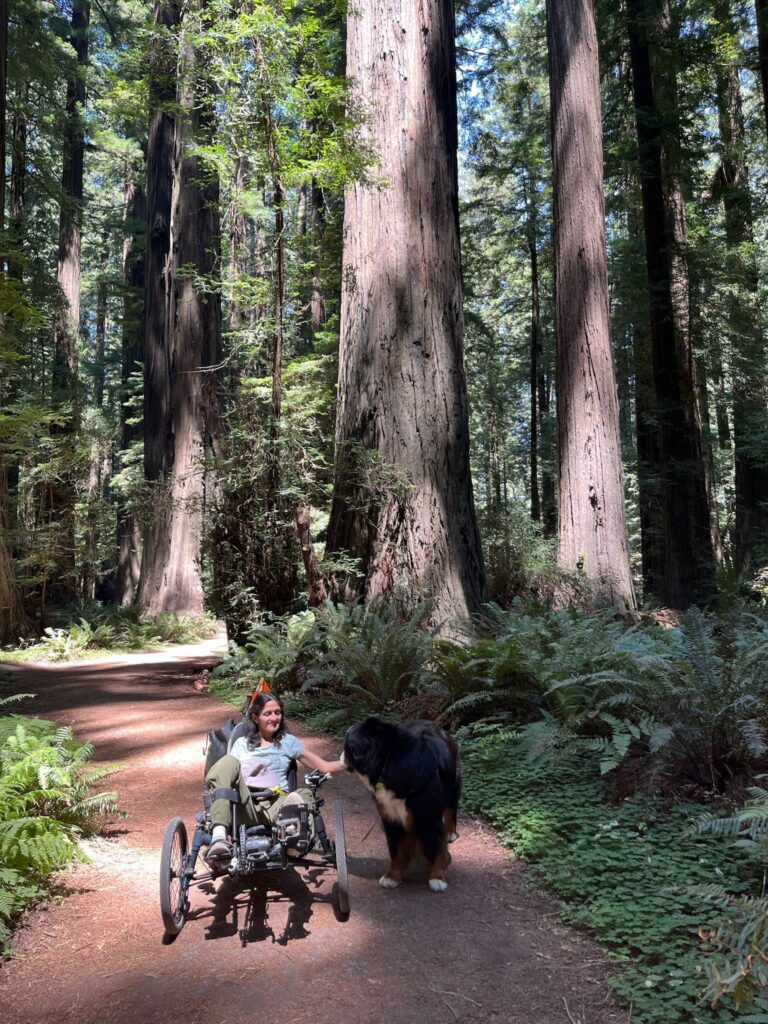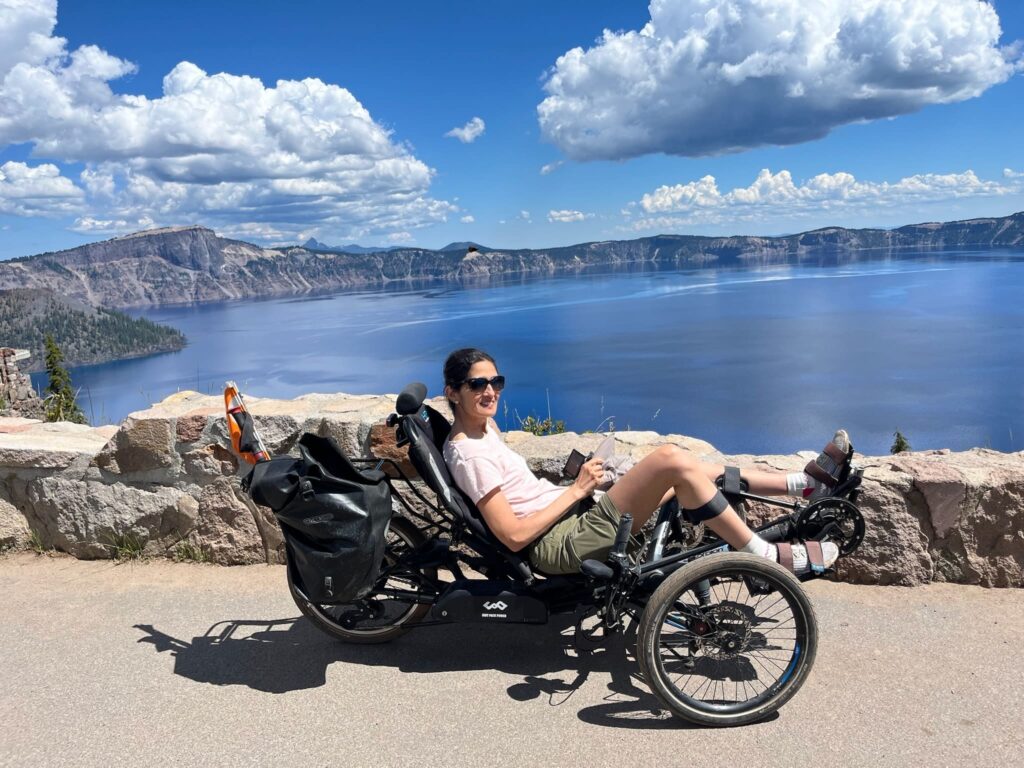Wheels on the Road: Exploring the Pacific Northwest by Car, WheelChair, and Trike
By Jan Bonville

Listen to this Article
The Road Begins
Green in every imaginable shade stretches as far as the eye can see. Majestic trees soar skyward, their moss-draped branches catching light that filters down like a halo. Gnarled trunks whisper in the damp air, as if part of an enchanted wood. Then the forest breaks open to reveal miles of wide, white beaches strewn with stones of every color and shape.
This is the Pacific Northwest at its most breathtaking—wild, lush, and timeless.
For me, this road trip—from San Francisco up through the redwoods of Northern California, along the Oregon coast, and into Washington’s Olympic and Crater Lake National Parks—was more than a scenic journey. It was a personal test.
A traditional roadtrip, that mode of vacation beloved by all walk of travelers, is, like most other travel experiences, fraught with its own peculiar anxiety for a woman with MS and a wheelchair user- like me. Whereas for many of my able friends, a roadtrip appeared a simple way to travel, for me, worries about adequately accessible rest stops, places to stay that would be both charming and sufficiently inclusive, and timing between drive stops, were omnipresent in the back of my mind. Yes, as readers of my column know, I’ve done complex trips in many inaccessible locations- but, the difference with this trip is it was entirely self-created and- as always- I sought inclusive friendliness over pure accessibility.
Our trip was a sliver of the fabled Pacific Northwest—from my home of San Francisco, starting up the coast to explore the giant redwoods of Humboldt County and Avenue of the Giants; then continuing up the entire Oregon coast, to the Olympic National Park and Peninsula in Washington, and returning via Crater Lake National Park in Oregon and then back home. We’d planned around 10- 11 days with stops every night. It would be my husband and I, our trusty minivan, our beloved Bernese Mountain dog, and my assorted mobility equipment: wheelchair, walker, and recumbent trike. While I am a wheelchair user, I can get out of the chair and move short distances with the walker and assistance and even manage steps with difficulty. I also prefer and usually use my trike, rather than my wheelchair, for outdoor activities such as park and trail exploration.
And so we set out. First stop: Redwoods state and national parks, Humboldt County, Northern California.

Among the Giants
Our first stop was the Avenue of the Giants, where no amount of reading can prepare you for the moment you find yourself beneath these colossal trees. Sunlight trickles down through branches hundreds of feet above, and the silence carries the weight of centuries. These redwoods—some over 2,000 years old—dwarf everything, even memory. Driving through, I felt both impossibly small and profoundly connected to something enduring.
The first time you see a giant redwood, you feel it before you understand it. The forest quiets, the air thickens with the scent of moss and bark, and then—suddenly—you are standing before a living column that soars skyward, higher than a thirty-story building.
This is Northern California’s redwood country, where trees older than empires rise in hushed groves that feel more like cathedrals than forests. Driving the winding roads toward Redwood National and State Parks, the shift is gradual—the trees growing taller, the light dimming, the world outside falling away—until you find yourself in the company of giants.
We had the good fortune to visit Founder’s Grove twice- once at dusk- no crowds, still and quiet. The fog drapes itself around the trunks, softening their outlines, and beads of moisture cling to ferns and wild sorrel carpeting the ground. Later, visiting midday, as the sun climbed higher, shafts of golden light broke through the canopy, illuminating the cinnamon-colored bark so that the trees themselves seem to glow. We also found a perfect trail for my trike- off a road, part of the state redwoods national park system- winding through the redwoods, past a stream, in the midst of ferns.
Being among the redwoods was humbling and a wonderful way to set things in perspective. It wasn’t just the scale—though standing beside a trunk as wide as a house can make anyone feel small. It is the sensation of stepping outside ordinary time. My travails with MS, being in a wheelchair, the numerous challenges—all seemed small and insignificant next to these trees.

Into the Emerald Heart: Exploring the Rainforest of Olympic National Park
On the western edge of Washington’s Olympic Peninsula, where the mountains meet the sea, lies one of the most enchanting landscapes in North America: a temperate rainforest that feels more myth than reality. Step beneath its canopy, and you are swallowed by green. Moss drapes from branches in long, trailing curtains. Ferns unfurl in dense carpets along the forest floor. Ancient spruces and hemlocks, some hundreds of years old, rise like guardians from a world both timeless and alive.
This is the Rain Forest, one of Olympic National Park’s crown jewels. Fed by nearly 12 feet of rain each year and bathed in the cool mists of the Pacific, the forest is lush beyond imagination. Every surface—trees, fallen logs, even stones—is softened with mosses and lichens. The air feels heavy, almost drinkable, perfumed with the scent of cedar, earth, and rain. These forests truly felt like something out of a fairytale: maples draped in green lace, archways of living wood, and shafts of light that pierce the canopy.
The famous Hoh Rain Forest, though stunning, proved difficult to navigate with crowds, stairs, and limited access for my trike. Instead, I found my spot near Lake Quinault, where the trails were quieter, the moss thicker, and the atmosphere every bit as magical. Staying at the Quinault River Inn—small, welcoming, and run by an owner who built a makeshift ramp to help me inside—I found the kind of inclusive hospitality that makes all the difference for a mobility impaired traveler like me. At night, sipping wine by the river with flower baskets swaying overhead, and hearing the sounds of the forest, I felt I was in one of my favorite childhood books of enchanted woods and lore.

Lakes and Volcanoes
Another highlight in Olympic National Park was Lake Crescent, a pristine alpine lake ringed by mountains and dense forest. Fallen trees, immense and sculptural, rested along the shoreline. And then in Oregon, there was Crater Lake, born of a volcanic eruption and now the deepest lake in the United States. Its impossibly vivid blue seemed to contain both fire and ice—a reminder of nature’s power to destroy and to create something sublime. We were able to find trails sufficiently wide for my trike- some were steep and I needed my engine, but the views made it all worthwhile.

The Realities of Accessible Travel
At every step of the way, I needed to find lodging. It isn’t hard to find accessible motels, and I did stay at many, but I actively sought lodging that would immerse me in nature- more authentic, more charming. The Pacific Northwest is the home of cabins- which I love, as they remind me of safari tents in Africa and are a fabulous way to combine the outdoors with creature comfort. Yet cabins with “rustic charm” often meant stairs and narrow doorways. I actively sought some out at strategic points along our route and made a point to call ahead of time to get the details. While many cabins weren’t fully accessible, they were welcoming and charming. For me, with my wheelchair and walker- and help of my husband- I was able to manage. I particularly liked the Union Creek Resort near Crater Lake in Oregon- we had a quiet cabin in the forest with an outdoor area, a log bed and friendly, helpful staff. (If you however cannot navigate these cabins, there are motels and hotels which are accessible, if less charming.)
Another critical detail was finding clean restrooms. Normally gas stations serve this purpose when I go on long drives in California- which can be hit or miss. The Rest Areas off highway 101 in Oregon stood out as particularly clean and wheelchair-friendly- almost each one we visited had at least one accessible restroom, a space to rest, and walk our dog.
One important note: crowds, make everything harder. Though July brought beautiful weather, I would not recommend midsummer for travelers with disabilities. The tourist attractions of Olympic National Park in particular were very crowded, with long lines to even enter the park. Crowds and lines are tough on everyone- for someone with a chronic health condition and the associated challenges, even more so. Early autumn, with cooler air and fewer visitors, might make for a far better experience.
Lessons from the Road
Rolling through forests older than empires, along coasts shaped by storms, and beside lakes carved from fire and ice, I was reminded that travel isn’t about ease—it’s about perspective. For those of us with disabilities, each journey requires creativity and resilience. But in return, it offers the freedom of discovery. Travel is empowering and gives us perspective, and adventure is for everyone- no matter our limitations.
I loved our road trip, and I’d do it again, next time, taking longer to drive between destinations and staying longer in the areas that we loved, such as Lake Quinault, Crater Lake, and taking more time to explore around Lake Crescent and the Oregon coast.
Tips for Disabled Adventurers
- Timing is everything:Avoid midsummer if you can—crowds make access harder. Early fall offers cooler air, fewer people, and beautiful light.
- Know your lodging:Many rustic cabins are not fully accessible but can provide a fabulous experience, based on your limitations. Call ahead—sometimes a welcoming owner makes all the difference and many went to pains to explain to me the dimensions. See my recommendations below of lodging that was particularly memorable.
- Restroom planning:Rest stops in Oregon in particular were impressively clean and wheelchair-friendly, but don’t rely solely on park facilities. Go when you can! There were long stretches of highway with absolutely no facilities.
- Trail research:“Accessible” often means “wheelchair-only.” If you use adaptive bikes or trikes, these will be restrictive, but you also can’t expect to use mountain bike paths which are too narrow. Ask other travelers for advice.
- Pack flexibility:A walker in addition to a wheelchair gave me freedom inside cabins and other tight spaces. If you are able to, take canes or walking poles as well.
Recommendations:- Note, the following are not all accessible but charming, helpful and inclusive
Quinault River Inn, Olympic National Park, Washington
The Lodge at St Edward Park, Kenmore, Washington (Does have ADA rooms, book in advance)
Union Creek, Crater Lake National Park
Mill Creek Resort, Lassen Volcanic National Park
